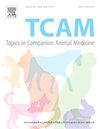巴西猫脓肉芽肿性病变中分离的马红球菌的鉴定。
IF 1.3
3区 农林科学
Q2 VETERINARY SCIENCES
引用次数: 0
摘要
本研究旨在描述2015年至2021年间从巴西家猫脓肉芽肿性病变中分离的三例马红球菌,并提供实验室特征。对位于腹部(病例1)和胸肢(病例1-3)的结节性皮肤病变的拭子和抽吸液进行微生物培养、生化和分子分析、生物膜形成能力评估和抗菌药物敏感性测试。猫1和猫2在SNAP检测中FeLV p27抗原阳性。病例1因红球菌感染并发症在家中死亡,病例2因药物和手术治疗感染失败而被安乐死。病例3为felv阴性的猫,接受口服红霉素和局部利福平治疗30天。然而,由于抗菌治疗未能解决病变,猫接受了受影响的右后肢截肢。在所有病例的微生物培养中均鉴定出质粒编码毒力相关蛋白A阳性的马芮氏杆菌。生物膜形成分析将这三种分离物归类为弱生物膜形成物。体外对阿奇霉素、克拉霉素、红霉素、亚胺培南和利福平均敏感。这些发现强调了巴西猫中马雷氏菌感染的临床、流行病学和实验室特征,表明这些微生物在表型和分子上与从马中分离出来的微生物相似。本文章由计算机程序翻译,如有差异,请以英文原文为准。
Characterization of Rhodococcus equi isolated from pyogranulomatous lesions in cats from Brazil
This study aimed to describe and provide a laboratory characterization of three cases of Rhodococcus equi isolates from pyogranulomatous lesions in domestic cats in Brazil, collected between 2015 and 2021. Swabs and aspirates from nodular skin lesions located in the abdominal region (Case 1) and thoracic limbs (Cases 1–3) were subjected to microbiological culture, biochemical and molecular analyses, evaluation of biofilm formation capacity, and antimicrobial sensitivity testing. Cats 1 and 2 were positive for FeLV p27 antigen on SNAP testing. Cat 1 died at home from complications of Rhodococcus infection, and Cat 2 was euthanized following failure of medical and surgical treatment of infection. The cat in Case 3, which was FeLV-negative, received treatment with oral erythromycin and topical rifampicin for 30 days. However, due to failure of antimicrobial therapy to resolve the lesions, the cat underwent amputation of the affected right hindlimb. R. equi, positive for the plasmid-encoded virulence-associated protein A, was identified on the microbiological cultures and PCR from all cases. Biofilm formation analysis categorized all three isolates as weak biofilm formers. Additionally, antimicrobial susceptibility testing revealed that all isolates were sensitive to azithromycin, clarithromycin, erythromycin, imipenem, and rifampicin in vitro. These findings underscore the clinical, epidemiological, and laboratory characteristics of R. equi infection in Brazilian cats, indicating that these microorganisms are phenotypically and molecularly similar to those isolated from horses.
求助全文
通过发布文献求助,成功后即可免费获取论文全文。
去求助
来源期刊

Topics in companion animal medicine
农林科学-兽医学
CiteScore
2.30
自引率
0.00%
发文量
60
审稿时长
88 days
期刊介绍:
Published quarterly, Topics in Companion Animal Medicine is a peer-reviewed veterinary scientific journal dedicated to providing practitioners with the most recent advances in companion animal medicine. The journal publishes high quality original clinical research focusing on important topics in companion animal medicine.
 求助内容:
求助内容: 应助结果提醒方式:
应助结果提醒方式:


